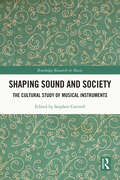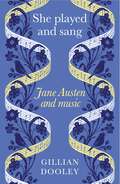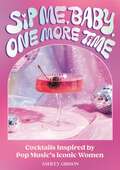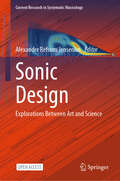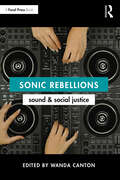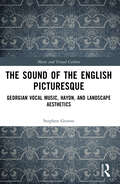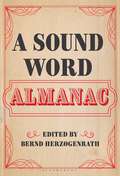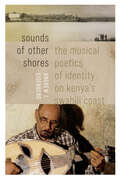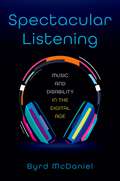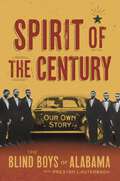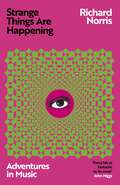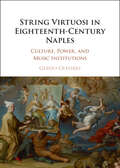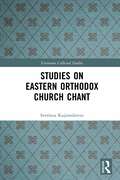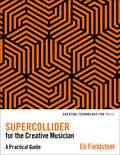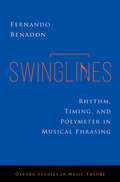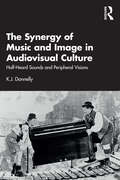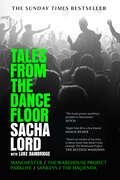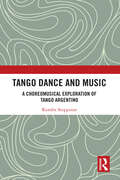- Table View
- List View
Shaping Sound and Society: The Cultural Study of Musical Instruments (Routledge Research in Music)
This volume brings together leading voices from the new wave of research on musical instruments to consider how we can connect the material aspects of instruments with their social function, approaches that have been otherwise too frequently separated in musical scholarship. Shaping Sound and Society: The Cultural Study of Musical Instruments locates the instruments at the centre of cultural interactions. With contributions from ten scholars spanning a variety of methodologies and a wide range of both contemporary and historic music cultures, the volume is divided into three sections. Contributors discuss the relationships between makers, performers, and their local communities; the different meanings that instruments accrue as they travel over time and place; and the manner in which instruments throw new light on historic music cultures. Alongside the scholarly chapters, the volume also includes a selection of shorter interludes based on interviews with makers of comparatively new instruments, offering further insights into the process of musical instrument innovation. An essential read for students and academics in the fields of music and ethnomusicology, this volume will also interest anyone looking to understand how the cultural interaction of musical instruments is deeply informed and influenced by social, technological, and cultural change.
She played and sang: Jane Austen and music
by Gillian DooleyLike her much-loved heroine Emma Woodhouse, Jane Austen ‘played and sang’. Music occupied a central role in her life, and she made brilliant use of it in her books to illuminate characters’ personalities and highlight the contrasts between them.Until recently, our knowledge of Austen’s musical inclinations was limited to the recollections of relatives who were still in their youth when she passed away. But with the digitisation of music books from her immediate family circle, a treasure trove of evidence has emerged. Delving into these books, alongside letters and other familial records, She played and sang unveils a previously unknown facet of Austen's world.This insightful work not only uncovers the music closely associated with Austen, but also unravels her musical connections with family and friends, revealing the intricate ties between her fiction and the melodies she performed. With these revelations, Austen's musical legacy comes to life, granting us a deeper understanding of her artistic prowess and the influences that shaped her literary masterpieces.
She played and sang: Jane Austen and music
by Gillian DooleyLike her much-loved heroine Emma Woodhouse, Jane Austen ‘played and sang’. Music occupied a central role in her life, and she made brilliant use of it in her books to illuminate characters’ personalities and highlight the contrasts between them.Until recently, our knowledge of Austen’s musical inclinations was limited to the recollections of relatives who were still in their youth when she passed away. But with the digitisation of music books from her immediate family circle, a treasure trove of evidence has emerged. Delving into these books, alongside letters and other familial records, She played and sang unveils a previously unknown facet of Austen's world.This insightful work not only uncovers the music closely associated with Austen, but also unravels her musical connections with family and friends, revealing the intricate ties between her fiction and the melodies she performed. With these revelations, Austen's musical legacy comes to life, granting us a deeper understanding of her artistic prowess and the influences that shaped her literary masterpieces.
Sip Me, Baby, One More Time: Cocktails Inspired by Pop Music's Iconic Women
by Ashley GibsonMy thirstiness is killing me . . . As gorgeous as your favorite album art and as irresistible as a catchy hook, a collection of stunning (and stunningly easy) cocktail recipes based on pop songs by iconic women. With a great drink in your hand and the perfect song playing, you can transform any place into your own personal party. Pop music is unmatched when it comes to capturing a feeling, and this book is inspired by the great songs and women who define this genre, as well as some lesser-known artists whose music is as exciting as stumbling upon a new favorite liqueur that adds just the flavor you&’ve been missing.Sip Me, Baby, One More Time combines the art of cocktail making with the power of these artists to create an experience curated by emotion. Each chapter of this book is a journey through a playlist dedicated to a specific feeling—from coping with soul-crushing heartbreak to feeling like you want to hop on a table and dance it out—and is filled with easy to make, beautiful cocktails dedicated to tracks from top female artists.Featuring drinks inspired by songs from Britney Spears, Beyoncé, Taylor Swift, Rihanna, Ariana Grande, Lana Del Rey, BLACKPINK, The Spice Girls, Doja Cat, and many more.
Sonic Design: Explorations Between Art and Science (Current Research in Systematic Musicology #12)
by Alexander Refsum JenseniusThis open access book offers a historical context and an overview of the field's current artistic and scientific research. Sonic design includes the construction and performance of acoustic instruments but also recording, editing, mixing, and synthesizing sounds using analog and digital electronic devices. This book explores sonic design from the perspectives of music theory, music perception, embodied cognition, phenomenology, soundscape studies, acoustics, new interfaces for musical expression, sound and music computing, and music information retrieval. The chapters are selected contributions from an international seminar organized to celebrate the achievements of Professor Rolf Inge Godøy at the University of Oslo. As a composer, researcher, teacher, and supervisor, Professor Godøy has been central in developing a holistic approach to sonic design, from theory to practice. This book offers a comprehensive overview of the field's current state, making it essential reading for students, practitioners, and researchers across a wide range of disciplines.
Sonic Rebellions: Sound and Social Justice
Sonic Rebellions combines theory and practice to consider contemporary uses of sound in the context of politics, philosophy, and protest, by exploring the relationship between sound and social justice, with particular attention to sonic methodologies not necessarily conceptualised or practiced in traditional understandings of activism.An edited collection written by artists, academics, and activists, many of the authors have multidimensional experiences as practitioners themselves, and readers will benefit from never-before published doctoral and community projects, and innovative, audio-based interpretations of social issues today. Chapters cover the use of soundscapes, rap, theatre, social media, protest, and song, in application to contemporary socio-political issues, such as gentrification, neoliberalism, criminalisation, democracy, and migrant rights. Sonic Rebellions looks to encourage readers to become, or consider how they are, Sonic Rebels themselves, by developing their own practices and reflections in tandem to continue the conversation as to how sound permeates our sociopolitical lives.This is an essential resource for those interested in how sound can change the world, including undergraduates and postgraduates from across the social sciences and humanities, scholars and instructors of sound studies and sound production, as well as activists, artists, and community organisers.
Sonic Rebellions: Sound and Social Justice
by Wanda CantonSonic Rebellions combines theory and practice to consider contemporary uses of sound in the context of politics, philosophy, and protest, by exploring the relationship between sound and social justice, with particular attention to sonic methodologies not necessarily conceptualised or practiced in traditional understandings of activism.An edited collection written by artists, academics, and activists, many of the authors have multidimensional experiences as practitioners themselves, and readers will benefit from never-before published doctoral and community projects, and innovative, audio-based interpretations of social issues today. Chapters cover the use of soundscapes, rap, theatre, social media, protest, and song, in application to contemporary socio-political issues, such as gentrification, neoliberalism, criminalisation, democracy, and migrant rights. Sonic Rebellions looks to encourage readers to become, or consider how they are, Sonic Rebels themselves, by developing their own practices and reflections in tandem to continue the conversation as to how sound permeates our sociopolitical lives.This is an essential resource for those interested in how sound can change the world, including undergraduates and postgraduates from across the social sciences and humanities, scholars and instructors of sound studies and sound production, as well as activists, artists, and community organisers.
The Sound of the English Picturesque: Georgian Vocal Music, Haydn, and Landscape Aesthetics (Music and Visual Culture)
by Stephen GrovesRevealing the connections between the veneration of national landscape and eighteenth- century English vocal music, this study restores English music’s relationship with the picturesque. In the eighteenth century, the emerging taste for the picturesque was central to British aesthetics, as poets and painters gained popularity by glorifying the local landscape in works concurrent with the emergence of native countryside tourism. Yet English music was seldom discussed as a medium for conveying national scenic beauty. Stephen Groves explores this gap, and shows how secular song, the glee, and national theatre music expressed a uniquely English engagement with landscape. Using an interdisciplinary approach, Groves addresses the apparent ‘silence’ of the English picturesque. The book draws on analysis of the visualisations present in the texts of English vocal music, and their musical treatment, to demonstrate how local composers incorporated celebrations of landscape into their works. The final chapter shows that the English picturesque was a crucial influence on Joseph Haydn’s oratorio The Seasons. Suitable for anyone with an interest in eighteenth- century music, aesthetics, and the natural environment, this book will appeal to a wide range of specialists and non- specialists alike.
The Sound of the English Picturesque: Georgian Vocal Music, Haydn, and Landscape Aesthetics (Music and Visual Culture)
by Stephen GrovesRevealing the connections between the veneration of national landscape and eighteenth- century English vocal music, this study restores English music’s relationship with the picturesque. In the eighteenth century, the emerging taste for the picturesque was central to British aesthetics, as poets and painters gained popularity by glorifying the local landscape in works concurrent with the emergence of native countryside tourism. Yet English music was seldom discussed as a medium for conveying national scenic beauty. Stephen Groves explores this gap, and shows how secular song, the glee, and national theatre music expressed a uniquely English engagement with landscape. Using an interdisciplinary approach, Groves addresses the apparent ‘silence’ of the English picturesque. The book draws on analysis of the visualisations present in the texts of English vocal music, and their musical treatment, to demonstrate how local composers incorporated celebrations of landscape into their works. The final chapter shows that the English picturesque was a crucial influence on Joseph Haydn’s oratorio The Seasons. Suitable for anyone with an interest in eighteenth- century music, aesthetics, and the natural environment, this book will appeal to a wide range of specialists and non- specialists alike.
A Sound Word Almanac
by Bernd HerzogenrathThis almanac of sound words important to artists and scholars highlights words that expand the way we speak (and write) about sonic experiences.Why write about sound, and how? If sonic philosophy is the attempt "to think about sound by philosophical means," then a metaphilosophical debate appears almost immediately on the horizon: What is called for is an understanding about sound and language, but also about the preconditions of musical understanding. What is at stake is the question of language and sound, as well as expanding how we speak about sonic experience.This almanac tackles these questions from artistic, experimental and personal perspectives. An assemblage of nearly 70 practitioners and theoreticians, artists and scholars offer their favorite 'sound word.' These sound words are onomatopoetical, mythological, practical; words of personal importance to the artists and their craft; words from their memory, related to sound. Many entries are not in English – some are untranslatable – and all are accompanied by a personal, explanatory, poetic entry. These are words that have the potential to change our perspective on listening-musicking-thinking.
Sounds of Other Shores: The Musical Poetics of Identity on Kenya's Swahili Coast (Music / Culture)
by Andrew J. EisenbergSounds of Other Shores takes an ethnographic ear to the history of transoceanic stylistic appropriation in the Swahili taarab music of the Kenyan coast. Swahili taarab, a form of sung poetry that emerged as East Africa's first mass-mediated popular music in the 1930s, is a famously cosmopolitan form, rich in audible influences from across the Indian Ocean. But the variants of the genre that emerged in the Kenyan coastal city of Mombasa during the twentieth century feature particularly dramatic, even flamboyant, appropriations of Indian and Arab sonic gestures and styles. Combining oral history, interpretive ethnography, and musical analysis, Sounds of Other Shores explores how Swahili-speaking Muslims in twentieth-century Mombasa derived pleasure and meaning from acts of transoceanic musical appropriation, arguing that these acts served as ways of reflecting on and mediating the complexities and contradictions associated with being "Swahili" in colonial and postcolonial Kenya. The result is a musical anthropology of Kenyan Swahili subjectivity that reframes longstanding questions about Swahili identity while contributing to broader discussions about identity and citizenship in Africa and the Indian Ocean world.
Spectacular Listening: Music and Disability in the Digital Age
by Byrd McDanielImagine a powerful listening experience that you want to share with others. You could describe it to someone with words, or you may choose a flashier alternative. You could, for example, costume yourself and take to the stage in a famous concert venue, delivering a rousing air guitar interpretation of a beloved rock solo for a live audience. Maybe you seek something more subtle, so you pull out your smartphone and record yourself lip-syncing to a guilty pleasure, showing your followers how seamlessly the music fits your movements. Perhaps instead you want others to hear how the music makes you feel, which leads you to record a podcast episode that translates the thrill of listening into audible exclamations. In ways both mundane and sensational, listening can be an expressive act, enabling people to stage consumption as a public practice -- what author Byrd McDaniel calls "spectacular listening." Contemporary digital platforms not only support such activity but actively encourage people to package personal music reception into a performance that may be widely shared. With a range of compelling ethnographic case studies, McDaniel investigates a broad shift in contemporary listening norms and the stakes for listeners with disabilities. He reveals how listening-as-performance can be an opportunity for play, as well as a critical practice that exposes ableism in music institutions, technologies, and discourse.
Spirit of the Century: Our Own Story
by The Blind Boys of AlabamaAn insider history of the Blind Boys of Alabama, the longest running group in American music, and the untold story of their world, written with band members and key musical colleagues. The Blind Boys of Alabama are the quintessential Gospel vocal group, and the longest-running musical institution in America. Their story intersects with pivotal moments and issues in American history and is an ideal prism through which to trace music, culture, history, and race in America. Spirit of the Century invites readers to follow along the Blind Boys&’ eight-decade journey together from a segregated trade school, through the rough and tumble indie record game and grinding tour schedule of the golden age of gospel, to starring in an iconic Broadway musical, performing at the White House for three presidents twice, collaborating with Tom Petty, Lou Reed, and Ben Harper, among others, singing the theme song for &“The Wire,&” and winning five Grammys. More than just a story of the Blind Boys' illustrious career, Spirit of the Century also sheds new light on the larger world of African American gospel music, its origins, and the colorful characters at its center. Though there have been several iterations of the group over the decades, Spirit of the Century rounds up all surviving members of the group as contributors to the telling of their own story, and a result, the book offers a unique and intimate perspective on the group's enduring success. Current drummer and road manager Rickie McKinney has been with the group throughout its renaissance, while guitarist Joey Williams, the group&’s sighted member, has been the eyes of the Blind Boys since 1992. Octogenarian Jimmy Lee Carter has a fascinating history, as a fellow student of the original but deceased Blind Boys Clarence Fountain, George Scott, Olice Thomas, Johnny Fields, J.T. Hutton, and Velma Traylor at the Talladega school. Carter is one of a few performers who have been in both the Blind Boys of Alabama and Mississippi. He fronts the Alabama group today as a classic quartet leader and fiery preacher. Along with extensive interviews of Fountain, these legendary musicians provide this book with the voice, firsthand perspective, and authenticity that bring their story the same inspirational power that you hear in their songs. Thought-provoking, heartfelt, and deeply inspiring, Spirit of the Century is a fascinating and one-of-a-kind read that you won't be able to put down.
Strange Things Are Happening
by Richard Norris'The rainbow reaches right across the sky, for miles and miles, and has landed right in the middle of our field. My mother, Alison, is standing at the beginning. I'm sure it's a beginning, rather than the end, as there's no pot of gold in sight. The point where everything forms or, perhaps, is not quite formed as yet. That's my favourite place. A place alive with possibility.'Strange Things Are Happening begins with the wonder of that rainbow, and continues with many escapades down the rabbit hole. From punk and the beginnings of the DIY scene, through Acid House, psychedelia, the rise of electronic dance music and much more, Richard Norris has been involved in countless countercultural revolutions. From misadventures in Amsterdam with Timothy Leary, with Sun Ra at customs, and Shaun Ryder in Joe Strummer's beaten up Cadillac in Tijuana, to his extraordinarily influential output in The Grid and Beyond The Wizards Sleeve, Richard Norris' story is one of collaboration and community, fuelled by relentless psychedelic curiosity.Strange Things Are Happening is a record of a life lived in the moment, forever in thrall to discovery, exploration and innovation - the search for what lies at the other end of that rainbow.
String Virtuosi in Eighteenth-Century Naples: Culture, Power, And Music Institutions
by Guido OlivieriStudies on Eastern Orthodox Church Chant (Variorum Collected Studies)
by Svetlana KujumdzievaThis book focuses on the compilation of the different practices of Eastern Orthodox Chant, looking at the subject through various languages, practices, and liturgical books and letters. The subject of this book is also analysed through newly found, unique material, to provide the entire history of Eastern Orthodox Chant, from the ninth to the nineteenth centuries and approached through a number of different disciplines. The book consists of sixteen topics, grouped in four parts: Studies on Genre, Studies on Liturgical Books, Studies on Distinguished Men of Letters, and Studies on Bulgarian Orthodox Church Chant. The aim of the book is to present the Eastern chant as a phase in the evolution of Mediterranean art, which is the cradle of Graeco-Roman heritage. This complex study brings in a variety of sources to show the purpose of Eastern Orthodox Chant as strengthening the Christian faith during the Middle Ages and the revival of Balkan nationalism in the nineteenth century. This book will appeal to students and scholars alike, interested in liturgical musical books, liturgy, and chant repertory. Likewise, it will be of interest to those engaged in medieval and early modern history, music, and culture.
Studies on Eastern Orthodox Church Chant (Variorum Collected Studies)
by Svetlana KujumdzievaThis book focuses on the compilation of the different practices of Eastern Orthodox Chant, looking at the subject through various languages, practices, and liturgical books and letters. The subject of this book is also analysed through newly found, unique material, to provide the entire history of Eastern Orthodox Chant, from the ninth to the nineteenth centuries and approached through a number of different disciplines. The book consists of sixteen topics, grouped in four parts: Studies on Genre, Studies on Liturgical Books, Studies on Distinguished Men of Letters, and Studies on Bulgarian Orthodox Church Chant. The aim of the book is to present the Eastern chant as a phase in the evolution of Mediterranean art, which is the cradle of Graeco-Roman heritage. This complex study brings in a variety of sources to show the purpose of Eastern Orthodox Chant as strengthening the Christian faith during the Middle Ages and the revival of Balkan nationalism in the nineteenth century. This book will appeal to students and scholars alike, interested in liturgical musical books, liturgy, and chant repertory. Likewise, it will be of interest to those engaged in medieval and early modern history, music, and culture.
SuperCollider for the Creative Musician: A Practical Guide (Creating Technology for Music)
by Eli FieldsteelSuperCollider, an open-source, cross-platform software program for real-time sound synthesis and algorithmic composition, was created by James McCartney in 1996 and has evolved to become a powerful tool for music composition and research. Written by composer and sound artist Eli Fieldsteel, who has almost two decades' experience of using SuperCollider for a variety of creative audio projects, SuperCollider for the Creative Musician is a comprehensive tutorial and reference guide for students, composers, and practitioners seeking a structured educational tour through this unique and flexible software. The book begins with platform-specific fundamentals, explores a large family of creative techniques, and then guides the reader through the nuances of assembling, navigating, and performing large-scale projects. Key topics include synthesis, sampling, sequencing, signal processing, external control, and graphical user interface design. Written with both beginners and intermediate practitioners in mind, this book is an invaluable resource for sound creators whose background falls anywhere on the spectrum between musician and computer programmer, and who seek to add new and innovative code-based techniques to their skill set. The companion website has an extensive collection of detailed code examples, which can be downloaded for exploration, experimentation, and hands-on learning.
Swinglines: Rhythm, Timing, and Polymeter in Musical Phrasing (OXFORD STUDIES IN MUSIC THEORY)
by Fernando BenadonThe way rhythm is taught in Western classrooms and music lessons is rooted in a centuries-old European approach that favors metric levels within a grand symmetrical grid. Swinglines encourages readers to experience rhythms, even gridded ones, as freewheeling affairs irrespective of the metric hierarchy. At its core, this book is a nuts-and-bolts study of durational comparisons in the context of creative expression. It shows that rhythms traditionally framed as "deviations" and "non-isochronous" have their own identities. They are coherent products of precise musical thought and action. Rather than situating them in the neither-here-nor-there, author Fernando Benadon takes a more inclusive view, one where isochrony and metric grids are shown as particular cases within the universe of musical time. Rhythms that do not readily comply with the metered regime are often regarded as anomalies and deformations. The music explored in this book demonstrates how readily this paradigm vanishes once the frame is flipped from what rhythm is not to what rhythm is. As conceptualized here, swing flattens the temporal field to consider how note values relate to one another by any magnitude, not just the simple ratios of traditional theory. Musical analyses illustrate the book's concepts with the aid of transcriptions and timing-data visualizations. Variation, tuplets, polymeter, displacement, phrase structure, rhythmic counterpoint, parallel tempos, cyclical patterns, and time signatures are shown to be particular expressions that draw their contours from the swing continuum. They showcase the rich diversity of rhythm and propose ways to reframe how we think about musical time.
The Synergy of Music and Image in Audiovisual Culture: Half-Heard Sounds and Peripheral Visions
by K.J. DonnellyThe Synergy of Music and Image in Audiovisual Culture: Half-Heard Sounds and Peripheral Visions asks what it means to understand music as part of an audiovisual whole, rather than separate components of music and film. Bringing together revised and updated essays on music in a variety of media – including film, television, and video games – this book explores the importance of partially perceived and registered auditory and visual elements and cultural context in creating unique audiovisual experiences. Critiquing traditional models of the film score, The Synergy of Music and Image in Audiovisual Culture enables readers across music, film, and cultural studies to approach and think about audiovisual culture in new ways.
The Synergy of Music and Image in Audiovisual Culture: Half-Heard Sounds and Peripheral Visions
by K.J. DonnellyThe Synergy of Music and Image in Audiovisual Culture: Half-Heard Sounds and Peripheral Visions asks what it means to understand music as part of an audiovisual whole, rather than separate components of music and film. Bringing together revised and updated essays on music in a variety of media – including film, television, and video games – this book explores the importance of partially perceived and registered auditory and visual elements and cultural context in creating unique audiovisual experiences. Critiquing traditional models of the film score, The Synergy of Music and Image in Audiovisual Culture enables readers across music, film, and cultural studies to approach and think about audiovisual culture in new ways.
Tales from the Dancefloor: Manchester / The Warehouse Project / Parklife / Sankeys / The Haçienda
by null Sacha LordLike most Mancunians of his age, Sacha Lord's life has been a tale of two cities. Then and now. Over the past three decades, Sacha has been in the eye of the storm of a musical and cultural revolution, from The Haçienda to The Warehouse Project. He has worked with the music industry’s most iconic acts including the Prodigy, New Order, Snoop Dogg, Fat Boy Slim, Skrillex, Calvin Harris, Four Tet, Fred again … and has thrown some of the biggest parties that the UK has ever seen. But it wasn’t an easy journey getting there. Tales from the Dancefloor gives readers an all-access pass to the people, music and chaos behind the scenes. From being shot at in a drive-by shooting and dealing with gangs and the criminal underworld, to the excess and demands of some of music’s biggest names, launching the country’s largest urban festival, Parklife, and much more, Sacha reveals all the highs and lows for the very first time. Tales from the Dancefloor, co-authored with bestselling author Luke Bainbridge, is a love letter to the city and the dance floor. This is an incredible story of resilience, creativity and innovation.
Tango Dance and Music: A Choreomusical Exploration of Tango Argentino
by Kendra StepputatThis book investigates choreomusical aspects of tango argentino in translocal practice, in particular its current manifestation in Europe. It looks at translocal tango argentino in its many facets: movement structures, sound structures, dancers and musicians, and the complex relations between these factors that all have their share in shaping the practice. Beyond being the first extensive monograph about translocal tango music and dance, the book crosses borders in the use of both qualitative and quantitative methods, ranging from participant observation to statistical data evaluation, including optical motion capture for movement analysis. The book contains a brief historical overview of tango argentino practice in the twentieth century, bringing together the development of music and dance in a holistic way to better understand the background of the current interconnectedness. The first main part of the book focuses on the “danceability” aspect of tango music. The exploration is based on tango DJs’, tango dance teachers’, and tango musicians’ view of tango danceability as well as experimental approaches. The second part is dedicated to tango dance and its “musicality”. It investigates with quantitative and qualitative methods tango movement repertoire and principles and how these relate to tango musical features.
Tango Dance and Music: A Choreomusical Exploration of Tango Argentino
by Kendra StepputatThis book investigates choreomusical aspects of tango argentino in translocal practice, in particular its current manifestation in Europe. It looks at translocal tango argentino in its many facets: movement structures, sound structures, dancers and musicians, and the complex relations between these factors that all have their share in shaping the practice. Beyond being the first extensive monograph about translocal tango music and dance, the book crosses borders in the use of both qualitative and quantitative methods, ranging from participant observation to statistical data evaluation, including optical motion capture for movement analysis. The book contains a brief historical overview of tango argentino practice in the twentieth century, bringing together the development of music and dance in a holistic way to better understand the background of the current interconnectedness. The first main part of the book focuses on the “danceability” aspect of tango music. The exploration is based on tango DJs’, tango dance teachers’, and tango musicians’ view of tango danceability as well as experimental approaches. The second part is dedicated to tango dance and its “musicality”. It investigates with quantitative and qualitative methods tango movement repertoire and principles and how these relate to tango musical features.
